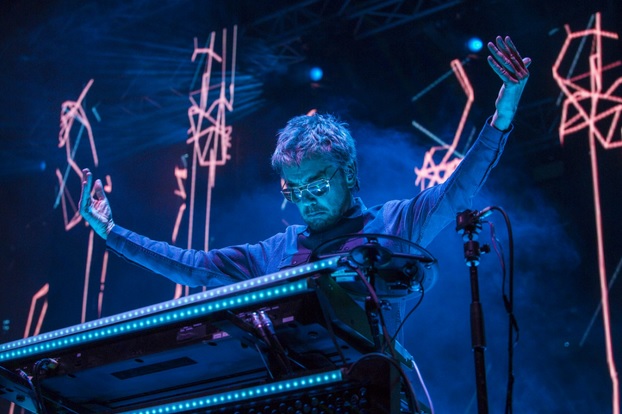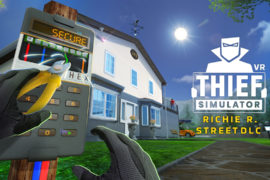A deep dive into VR concerts, what’s happening in the industry, and hopes for the future.
As 2020 draws to a close, I continue to search for the next killer app combining music and technology in the context of virtual concerts.
Millions of dollars are being spent on one-off productions like in-game concerts hosted in Epic Games’ Fortnite, Tomorrowland’s 2D streaming festival, and clunky live performances in Minecraft just to name a few. To get a better understanding of where the virtual concert industry is and where it’s all going, here’s an excellent five minute video by VR pioneer artist Miro Shot that explains it all:
In a nutshell, a true virtual concert must feature a live performance element, plenty of interactivity, and the ability for fans to communicate with one another beyond throwing an emoji. Otherwise, it’s just a glorified stream.
With these distinctions in mind, I sat down virtually with Jean-Michel Jarre, the godfather of modern electro, to talk frankly about his VR concerts and his hopes for the future of virtual concerts, including the challenges an artist may face if they want to work with this new and volatile technology. You might know Jarre from his albums Oxygène or Équinoxe which helped defined the genre we now know as modern-day EDM (electronic dance music).
Today, Jarre still holds the world record for the largest-ever audience at an outdoor event for his Moscow concert on September 6, 1997, which was attended by 3.5 million people.
Defining Virtual Concerts
When I spoke to Jarre about virtual concerts, like Miro Shot, he was firm regarding the definition of a “virtual concert” and the importance of live music.
“There are very few real experiences. You have, for instance, pre-recorded experiences such as Travis Scott, a pre-recorded session in a pre-existing game, and it’s not real,” said Jarre, who is performing his second virtual concert on December 31st. “A live experience is something else. I have lots of respect for these, but it’s different. It’s actually very close to what they’re doing in special effects for movies where you have a green screen, and a singer in front and it has been shot in 360.”
“What I’m really trying to do for this project is to actually go for a real live concert that you experience in a 3D world with your VR headset.”
The evolution of virtual concerts reminds Jarre of cinema at the beginning of its era in the late 1890’s. He highlights how the very first simple projections weren’t taken seriously by theatre-goers. Cut to today and modern cinema accounts for some of our most important works of art.
“Rather than weakening theatre, it actually reinforced it, like TV for cinema. I think that it’s the same for people using VR these days,” added Jarre. “The path of the artist is to experiment. What’s always been interesting in any kind of art form in history is people hijacking the environment. An interesting approach is a kind of Banksy approach. So you take something and you hijack it, and this is the only way to create your own art.”
“You know, in music, you only have 12 notes, and then you have millions of songs. What makes the difference though is not technology, it’s what you have in your heart and in your mind.”
“It’s easy to become trapped in the idea that technology has the answer for everything,” he said, “It doesn’t have an answer for your own inspiration, but you can be inspired by technology and hijack it to create your own world, and that is why I think VR is very exciting for newcomers and beginners. It’s not every generation where you have the possibility to open doors on virgin territories, and that’s what VR is all about these days.”
Paradigm Shift
When asked about the global pandemic and its impact on digital habits, Jarre is pragmatic.
“If there’s one positive aspect to this period, it’s that history is playing the role of an accelerator for all these techniques. Even people quite remote from the digital world have had to dare to be involved just to talk to their families or work,” he said, adding, “Suddenly, they are getting not only information but also media content and cultural content from the screen that is now much more familiar and mainstream in the world. And because of course the fact that we’ve been locked down for so long during this year, people are ready to go to a virtual show.”
Despite Jarre’s optimism and romance with technology, he is fully aware of the challenges that the music industry and artists are facing, both pre and post-pandemic.
“In 2020, we realized that we need to fix this,” says Jarre. “If we didn’t have the proof before, now we have it that music and visual arts are the means and products of first necessity.”
When we talk about the way that streaming technology has impacted musicians and art in general, Jarre’s tone changes, leaping to the defense of fellow artists in face of the way technology has turned the old music industry upside down:
“You know, you have platforms, such as Spotify for instance, during the quarantine saying to give some money to artists you like. We can’t accept that. All that has to be reevaluated and re-adjusted for all of us, otherwise, it will be total despair. So many artists, even now, have just had to abandon their work and it’s really sad.”
“It’s just the fact that we need music as we need food, you know, and it’s the same value. As a part of the community, we must participate and we must pay for that,” says Jarre.
He makes a compelling point. The importance of art and culture in society, especially in such difficult times, should be balanced with the power of new technology.
Video Games
Even though the music industry is keen to use this new technology, it is strange and alien to them in many ways. Like cinema producers, artists are also exploring the idea of interaction in a way that is unique to their art form.
One of these paradigm shifts are the pre-recorded music events taking place in games like Fornite and Minecraft. However, Jarre says that when music is the core focus of the project, the design of the game must change entirely to make way for the performance.
“In video games, you are at the heart and priority of the action, lights, and environment design, but a gig is different,” said Jarre. “The elements of design are entirely different. The atmosphere and a sensual approach towards lighting and textures is key. We have to explore new ways to express this.”
In gaming, agency plays a huge role in the audience coming to and interacting with the experience. When I ask Jarre what he thinks about how agency will evolve in the context of virtual concerts, he has a strong opinion on the subject.
“You know, it’s a very tricky question this one because we are all obsessed with controlling our environment constantly by having more and more control over everybody and everything. We are controlled, and we want to control at the same time,” he explained.
“When we’re watching a movie, or reading a book, or listening to music, it’s not necessarily changing chapter five or six because we don’t like it. If we’re watching a movie the director, the actors, they are inviting us to share the storytelling and the dream from A to Z. If you break this, sometimes it’s weakening the old story rather than reinforcing.”
“When you are in the gig or in a show where you have lots of spectators and a big audience, if somebody starts to change what’s going to happen it can become chaos very, very quickly. In all experiments that have been done in real life to give control to the masses, most of the time it ends up being cheesy because you have half of the arena doing blue and the other red or these kinds of basic things. Or if it’s more sophisticated, it becomes very complex, and by the end of the day, it’s not very exciting.”
The State of the Industry
Speaking to Jarre, I am struck that it took a full pandemic for us to get a better understanding of technology in our lives and how it can be used to make things better. It’s also a shame that the music industry didn’t see earlier the value of VR as a creative tool for artists to make something far more compelling than a basic 2D stream.
Jarre’s hybrid concert is not the first to take place. UK band Miro Shot began experimenting with virtual worlds, game engines, and hybrid concerts in 2017 as part of a three-day residency at the Institute of Contemporary Art in Amsterdam, and they continue to experiment with VR in their hybrid live concerts, some of which even featuring multiplayer gaming elements. The band recognized early on how VR can serve as a powerful tool to captivate audiences like never before.
Jarre and Miro Shot are both brave to experiment with hybrid virtual concerts where failure and success can be a very public occurrence.
Jarre’s first iteration of a virtual concert, Alone Together, brought awareness to the virtual medium, but it was also ripe with technical difficulties to the extent that when I arrived at the venue in the virtual world, there was no artist on stage, and no music to be heard of. Due to platform limitations in VRChat where the virtual concert took place, only the first 40 people, VIP members of the industry and press, were able to experience the performance as it was imagined.
There is a lot of work to be done before VR concerts become a viable experience for the masses, both in terms of artists having access to the tools and technology companies providing the support.
It’s impossible to say who will be the first artist to get this new medium “right”, but one thing is for sure, in terms of ambition, resources, charisma and talent, the immersive technology community is in good hands working alongside Jarre.
After speaking with him though, it feels like this isn’t about novelty or new technology. Jarre is an artist who in many ways is doing what he has always done, pushing himself and his music to do something that is a disruption of all that has come before, and yet another beautifully romantic celebration of what music can be, and what it always was.
You can Jean-Michel Jarre’s upcoming virtual concert Welcome to the Other Side on New Year’s Eve.
Feature Image Credit: Erik Voake
The post Virtual Concerts Need A “Banksy Style” Hijacking Says Electronic Music Pioneer Jean-Michel Jarre appeared first on VRScout.




